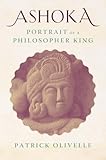Ashoka portrait of a philosopher king Patrick Olivelle
Material type: TextLanguage: English Series: Indian Lives ; 1Publication details: Gurugram, Haryana HarperCollins 2023Description: xxxix, 356 pages, 8 unnumbered pages of plates illustrations( chiefly color), map 24 cmISBN:
TextLanguage: English Series: Indian Lives ; 1Publication details: Gurugram, Haryana HarperCollins 2023Description: xxxix, 356 pages, 8 unnumbered pages of plates illustrations( chiefly color), map 24 cmISBN: - 9780300270006
- Portrait of a philosopher king
| Item type | Current library | Collection | Call number | Status | Date due | Barcode | |
|---|---|---|---|---|---|---|---|
| Book | French Institute of Pondicherry | IFP Social Science collection | HIST 3860 (Browse shelf(Opens below)) | Available | SS21900 |
Includes bibliographical references (pages 325-340) and index.
The many Ashokas -- Ashoka by any other name -- Rājā : Ashoka the king -- Maurya -- Ruler -- Writer -- Builder -- Upāsaka : Ashoka the Buddhist -- Deepening the faith -- Exhorting the sangha -- Spreading the faith -- Dharma : Ashoka the moral philosopher -- Pivoting to dharma -- Dharma as moral philosophy -- Preaching dharma -- Pāṣaṇḍa : Ashoka the ecumenist -- Religious diversity -- Ecumenism -- Civil religion -- Ashoka's legacy and the unravelling of the Ashokan experiment.
Ashoka, the last great Mauryan emperor, is one of the most iconic figures in Indian history. Under his rule (268-232 BCE) the Mauryan empire extended across almost the entirety of the Indian subcontinent. Apart from his effective reign over his vast kingdom, Ashoka is well known for his renunciation of war, his development of the concept of dhamma, his patronage of Buddhism, and his promotion of religious harmony. Ashoka has been imagined, and reimagined, many times over. It has been said that there are at least two Ashokas: the historical Ashoka (whom we know mainly through his inscriptions), and the legendary Ashoka, who is largely a construct of the popular imagination. The distinguished scholar Patrick Olivelle's new book resists the temptation to blend the two-a temptation that many writers have succumbed to-as it seeks to gain an insight into the emperor's world. Based primarily on the inscriptions (which is where Ashoka 'speaks for himself'), Olivelle constructs a fascinating portrait of India's first great ruler, where the figure of Ashoka comes vividly alive notwithstanding the elusiveness and fragmentary nature of the sources.
There are no comments on this title.

